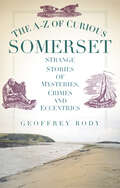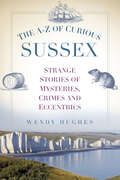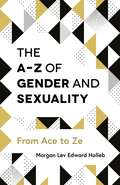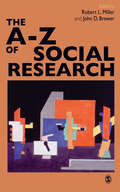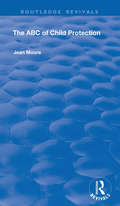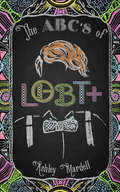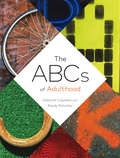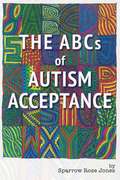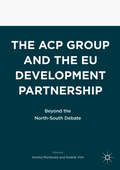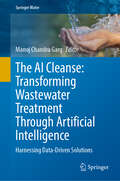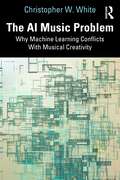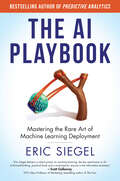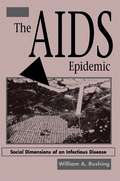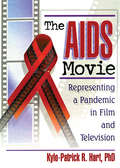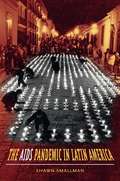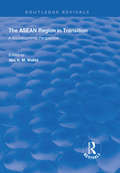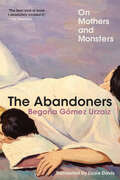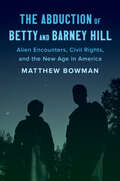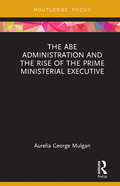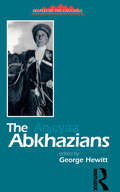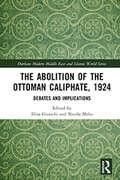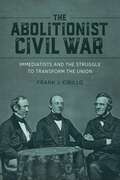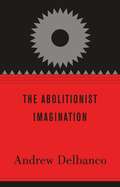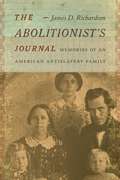- Table View
- List View
The A-Z of Curious Somerset: Strange Stories of Mysteries, Crimes and Eccentrics (A-Z of Curious)
by Geoffrey BodyThis book draws on the long and unique heritage of the county of Somerset, bringing to life seventy of the little known but fascinating and unusual aspects of a much-loved area. It tells of body-snatchers and bewitchment; crime and conflict; lepers and lighthouses; songs and words; heroes and villains – this is book is of and for the curious. Its accounts of larger-than-life episodes from Somerset activity, locations and people take the reader on a near-unbelievable exploration of local human behaviour and idiosyncrasy. Richly illustrated, this book is great for dipping into, but can equally be enjoyed from cover to cover.
The A-Z of Curious Sussex: Strange Stories of Mysteries, Crimes and Eccentrics
by Wendy HughesIn this engaging book, Wendy Hughes takes you on a grand tour of the curious and bizarre, the strange and the unusual from Sussex’s past. Read about the Alfriston Star – the hostelry for medieval package tours with its unusual ship’s figurehead, the Russian memorial to Finnish soldiers, Crazy Jack who couldn’t stop building and who is buried in a pyramid, the inventor of vapour baths and the lady who fooled the army. Along the way you will meet scandalous residents, inventors, and smugglers galore. The A-Z of Curious Sussex is guaranteed to fascinate both resident and visitor alike.
The A-Z of Gender and Sexuality: From Ace to Ze
by Morgan Lev HollebThere can be confusion around the appropriate terminology for trans and queer identities, even within the trans community itself. As language is constantly evolving, it can be especially difficult to know what to say. As a thorough A-Z glossary of trans and queer words from 'ace' to 'xe', this dictionary guide will help to dispel the anxiety around using the "wrong" words, while explaining the weight of using certain labels and providing individuals with a vocabulary for personal identification.Having correct and accurate terminology to describe oneself can be empowering, especially with words and phrases that describe gender identity, sexuality, sexual orientation, as well as slang relevant to LGBTQ+ rights and anti-discrimination, queer activism, gender-affirming healthcare and psychology. Written in a traditional A-Z glossary style, this guide will serve as a quick reference for looking up individual words, as well as an in-depth look at trans history and culture.
The A-Z of Social Research: A Dictionary of Key Social Science Research Concepts
by Robert L. Miller John D. Brewer`A detailed and valuable addition to the literature that will be a very useful resource for lecturers, as well as having a wide appeal among students′ - Tim May, University of Salford Have you ever wondered what a concise, comprehensive book providing critical guidance to the whole expanse of social science research methods and issues might look like? The A-Z is a collection of 94 entries ranging from qualitative research techniques to statistical testing and the practicalities of using the Internet as a research tool. Alphabetically arranged in accessible, reader-friendly formats, the shortest entries are 800 words long and the longest are 3000. Most entries are approximately 1500 words in length and are supported by suggestions for further reading. The book: - Answers the demand for a practical, fast and concise introduction to the key concepts and methods in social research - Supplies students with impeccable information that can be used in essays, exams and research projects - Demystifies a field that students often find daunting This is a refreshing book on social research methods, which understands the pressures that modern students face in their work-load and seeks to supply an authoritative study guide to the field. It should fulfil a long-standing need in undergraduate research methods courses for an unpatronising, utterly reliable aid to making sense of research methods.
The ABC of Child Protection (Routledge Revivals)
by Jean MooreFirst published in 1992, this volume, a completely new work and companion to the best seller The ABC of Child Abuse Work, keeps alive the theme of the child’s perspective. This new book examines four faces of abuse in detail: physical abuse, children caught up in marital violence and the much neglected subject of neglect, so often ignored in many texts. Because of the high anxiety that surrounds sexual abuse, particular attention has been paid to this subject with a step-by-step interdisciplinary approach for working with the sex offender, the non-offending parent and the sexually abused child. There is also a section devoted to understanding and working with female sex offenders. The painful stresses experienced by the worker are not forgotten and emphasis is put upon the specific skills required in child protection work. There is a lively chapter on face-to-face work with abused children the complexities of child protection conferences are helpfully analysed with particular reference to the attendance of parents and children. The black perspective is given prominence with contributions from Emmanuel Okine and David Divine. A chapter by Caroline Ball describes the contents and implications of the 1989 Children Act. Issues relating to racism, sexism, classism, ageism and disabilityism are honestly tackled. The ABC of Child Protection aims to continue the development of a better service for abused children and their families. It serves as a guide to students on qualifying courses and for experienced professionals who wish to extend their practice in this area.
The ABC's of LGBT+: (gender Identity Book For Teens, Teen And Young Adult Lgbt Issues)
by Ashley MardellThe YouTube star presents a personal, approachable, and informative guide for anyone seeking a deeper understanding of gender and sexual identity. The ABCs of LGBT+ is essential reading for questioning teens, teachers or parents looking for advice, or anyone who wants to learn how to talk about gender and sexual identity. In this volume, popular vlogger Ash Mardell, who embraces all pronouns, answers your questions about the post-binary world of the twenty-first century. With in-depth definitions, personal anecdotes, helpful infographics, resources, and more, Mardell lets readers know that it really does get better when we are empowered by information and understanding. In Mardell&’s own words, "This book is also for allies and LGBT+ people simply looking to pack in some extra knowledge . . . a critical part of acceptance. Learning about new identities broadens our understanding of humanity, heightens our empathy, and allows us different, valuable perspectives.&” Topics covered include: · LGBT and LGBTQIA+ · Gender identity · Sexual identity · Teens in a binary world · The LGBT family and more
The ABCs of Adulthood: An Alphabet of Life Lessons
by Deborah Copaken Randy PolumboHere's a book of wit and wisdom that's perfect for any "welcome to the adult world" moment. From New York Times bestselling author Deborah Copaken and noted sculptor Randy Polumbo come 26 genuine and funny bits of advice as surprising as they are sensible. From "A is for Anger" through "Z is for Zzzzzzz," each entry is paired with the authors' street-smart photography of the matching alphabet letter to create a savvy ebook. Based on a viral article written by Copaken when her own firstborn left for college, The ABCs of Adulthood is a delightful, worldly riff on learning your ABCs all over again.
The ABCs of Autism Acceptance
by Sparrow Rose JonesIn The ABCs of Autism Acceptance, Sparrow takes us through a guided tourof the topics most central to changing the way that autism is perceived, toremove systemic barriers to access that have traditionally been barriers toAutistic participation in some sectors of society. They also take us through thebasics of Autistic culture, discussing many of its major features and recentdevelopments with a sense of history and making the current state of theconversation around this form of neurodivergence clear to those who are new toit, whether they are Autistic themselves or a friend/family member looking forresources to help themselves support the Autistic people in their lives more fully.
The ACP Group and the EU Development Partnership
by Annita Montoute Kudrat VirkThis book constitutes a systematic and critical assessment of the nature, evolution, and prospects of the development partnership between the 79-member African, Caribbean, and Pacific (ACP) group of states and the 28-member European Union (EU). A core theme that runs through the work is that the ACP's partnership with the EU remains an important framework for addressing development challenges in the African, Caribbean, and Pacific regions, but needs to adapt to changes in the global political economy, as well as internal developments in both the ACP and the EU, to sustain its relevance and effectiveness. This is crucial for the ACP group, in particular, given its origins in, and core focus on, development cooperation with Europe. The authors in this volume examine the history of the ACP-EU partnership since 1975; the EU's relationship with the African, Caribbean, and Pacific regions individually; ACP experiences with economic partnership agreements with the EU; and new political issues, in particular, security, migration, and diasporas. Shedding light on the future prospects of this relationship, this book will be of interest to both scholars and policymakers working on the ACP-EU relationship and related development issues, including trade, aid, security, and migration.
The ACTA and the Plurilateral Enforcement Agenda
by Pedro Roffe Xavier SeubaThe Anti-Counterfeiting Trade Agreement (ACTA) is the most important effort undertaken to lay down a plurilateral legal framework for the enforcement of intellectual property rights. With the view to learn more about the origins of this treaty, the process leading to its conclusion and its implications for law making in this field, The ACTA and the Plurilateral Enforcement Agenda: Genesis and Aftermath analyses in great depth both the context and the content of the agreements. In order to attain this objective, a large and diverse group of experts - renowned scholars, policy makers and civil society actors - who represent different perspectives on the necessary balance between intellectual property enforcement and other economic and social interests have been gathered together. This book is the most comprehensive analysis of ACTA, and of its relation with ongoing initiatives to improve enforcement of intellectual property and norms pertaining to a range of international legal regimes, conducted so far.
The AI Cleanse: Harnessing Data-Driven Solutions (Springer Water)
by Manoj Chandra GargThis groundbreaking book goes beyond conventional approaches and explores how AI is revolutionizing the field of wastewater treatment, offering innovative solutions to pressing challenges. "The AI Cleanse" takes you on a captivating journey through the convergence of AI and wastewater treatment, revealing the potential for enhanced efficiency, effectiveness, and sustainability. From optimizing treatment processes to intelligent monitoring and fault detection, this book showcases how AI-driven technologies can reshape the way we approach wastewater treatment.Gain a comprehensive understanding of the basics of wastewater treatment and the limitations of traditional methods. Explore the practical applications of AI, such as data acquisition and analysis, process optimization, and resource recovery. Learn about cutting-edge technologies, emerging trends, and future directions in the field.Written in a reader-friendly style, "The AI Cleanse" bridges the gap between theoretical knowledge and practical implementation. Packed with real-world examples, case studies, and insights from experts in the field, this book equips researchers, professionals, and students with the knowledge needed to harness the full potential of AI in wastewater treatment.If you are passionate about environmental preservation, sustainable practices, and the power of technology, "The AI Cleanse" is your guide to unlocking the transformative potential of artificial intelligence in wastewater treatment. Embrace a cleaner future and be at the forefront of this revolution in the field.
The AI Music Problem: Why Machine Learning Conflicts With Musical Creativity
by Christopher W. WhiteMusic poses unique and complex challenges for artificial intelligence, even as 21st-century AI grows ever more adept at generating compelling content. The AI Music Problem: Why Machine Learning Conflicts With Musical Creativity probes the challenges behind AI-generated music, with an investigation that straddles the technical, the musical, and the aesthetic. Bringing together the perspectives of the humanities and computer science, the author shows how the difficulties that music poses for AI connect to larger questions about music, artistic expression, and the increasing ubiquity of artificial intelligence. Taking a wide view of the current landscape of machine learning and Large Language Models, The AI Music Problem offers a resource for students, researchers, and the public to understand the broader issues surrounding musical AI on both technical and artistic levels. The author breaks down music theory and computer science concepts with clear and accessible explanations, synthesizing the technical with more holistic and human-centric analyses. Enabling readers of all backgrounds to understand how contemporary AI models work and why music is often a mismatch for those processes, this book is relevant to all those engaging with the intersection between AI and musical creativity today.
The AI Playbook: Mastering the Rare Art of Machine Learning Deployment (Management on the Cutting Edge)
by Eric SiegelIn his bestselling first book, Eric Siegel explained how machine learning works. Now, in The AI Playbook, he shows how to capitalize on it.&“Eric Siegel delivers a robust primer on machine learning, the key mechanism in AI. A forward-looking, practical book and a must-read for anyone in the information economy.&” —Scott Galloway, NYU Stern Professor of Marketing; bestselling author of The Four &“An antidote to today&’s relentless AI hype—why some AI initiatives thrive while others fail and what it takes for companies and people to succeed.&”—Charles Duhigg, author of bestsellers The Power of Habit and Smarter Faster BetterThe greatest tool is the hardest to use. Machine learning is the world&’s most important general-purpose technology—but it&’s notoriously difficult to launch. Outside Big Tech and a handful of other leading companies, machine learning initiatives routinely fail to deploy, never realizing value. What&’s missing? A specialized business practice suitable for wide adoption. In The AI Playbook, bestselling author Eric Siegel presents the gold-standard, six-step practice for ushering machine learning projects from conception to deployment. He illustrates the practice with stories of success and of failure, including revealing case studies from UPS, FICO, and prominent dot-coms. This disciplined approach serves both sides: It empowers business professionals, and it establishes a sorely needed strategic framework for data professionals. Beyond detailing the practice, this book also upskills business professionals—painlessly. It delivers a vital yet friendly dose of semi-technical background knowledge that all stakeholders need to lead or participate in machine learning projects, end to end. This puts business and data professionals on the same page so that they can collaborate deeply, jointly establishing precisely what machine learning is called upon to predict, how well it predicts, and how its predictions are acted upon to improve operations. These essentials make or break each initiative—getting them right paves the way for machine learning&’s value-driven deployment.What kind of AI does this book cover? The buzzword AI can mean many things, but this book is about machine learning, which is a central basis for—and what many mean by—AI. To be specific, this book covers the most vital use cases of machine learning, those designed to improve a wide range of business operations.
The AIDS Epidemic: Social Dimensions Of An Infectious Disease
by William A RushingThis comprehensive introduction to the problem of AIDS lays out the medical facts and social epidemiology of the disease and illuminates the complex social problems this disease poses for the United States and other nations. Each chapter introduces a key sociological approach that clarifies how social scientists understand and explain important social dimensions of the AIDS epidemic. The authors use of historical comparisons with other deadly epidemics sets in relief the social problems presented by AIDS today. AIDS has become the most vexing medical crisis of our time. But the social aspects of the epidemic are just as complex as the biomedical aspects of the disease, sharing sociological characteristics with the Black Death, cholera, and other devastating epidemics of earlier eras.This comprehensive introduction to the problem of AIDS lays out the medical facts and social epidemiology of the disease and illuminates the complex social problems this disease poses for the United States and other nations. Each chapter introduces a key sociological approach that clarifies how social scientists understand and explain important social dimensions of the AIDS epidemic. The authors use of historical comparisons with other deadly epidemics sets in relief the social problems presented by AIDS today.
The AIDS Movie: Representing a Pandemic in Film and Television
by Kylo-Patrick R HartAre people with HIV/AIDS treated fairly in films?Here is a compelling book that provides you with a thorough examination of how HIV/AIDS is characterized and portrayed in film and how this portrayal affects American culture. The AIDS Movie: Representing a Pandemic in Film and Television uncovers the primary ways that films about HIV/AIDS influence American ideology and contribute to society's view of the disease. In The AIDS Movie, professors and scholars in the areas of popular culture, film, sociology, and gay and lesbian studies will discover cross-cultural approaches that can be used to analyze the representation of AIDS in American films made in the first two decades of the pandemic. Giving you insight into the production and circulation of social meanings pertaining to HIV/AIDS, this study explores the social ramifications of such representations for gay men in American society, as well as for the rest of the population. Interesting and informative, The AIDS Movie: Representing a Pandemic in Film and Television examines the ways that AIDS has been represented in American movies over the past two decades, defines and proposes criteria for identifying an “AIDS movie” and explores how these images shape social opinions about AIDS and gay men. The AIDS Movie discusses several character types such as “innocent victims” and “guilty villains” and the process of victim-blaming that occurs in AIDS movies. Defining an “AIDS movie” as a film with at least one character who either has been infected with HIV, has developed AIDS, or is grieving the recent death of a loved one from AIDS, this guide bases standards for these movies on several works, including: Chocolate Babies It's My Party Jeffrey The Living End Grief An Early Frost Men in Love A Place for Annie Philadelphia The Ryan White Story Gia Boys on the SideThe AIDS Movie: Representing a Pandemic in Film and Television is compelling and insightful as it cleverly reveals how AIDS is portrayed in cinema and television, and how that portrayal affects American culture.
The AIDS Pandemic in Latin America
by Shawn C. SmallmanOf the more than 40 million people around the world currently living with HIV/AIDS, two million live in Latin America and the Caribbean. In an engaging chronicle illuminated by his travels in the region, Shawn Smallman shows how the varying histories and cultures of the nations of Latin America have influenced the course of the pandemic. He demonstrates that a disease spread in an intimate manner is profoundly shaped by impersonal forces.In Latin America, Smallman explains, the AIDS pandemic has fractured into a series of subepidemics, driven by different factors in each country. Examining cultural issues and public policies at the country, regional, and global levels, he discusses why HIV has had such a heavy impact on Honduras, for instance, while leaving the neighboring state of Nicaragua relatively untouched, and why Latin America as a whole has kept infection rates lower than other global regions, such as Africa and Asia. Smallman draws on the most recent scientific research as well as his own interviews with AIDS educators, gay leaders, drug traffickers, crack addicts, transvestites, and doctors in Cuba, Brazil, and Mexico. Highlighting the realities of gender, race, sexuality, poverty, politics, and international relations throughout Latin America and the Caribbean, Smallman brings a fresh perspective to understanding the cultures of the region as well as the global AIDS crisis.
The ASEAN Region in Transition: A Socioeconomic Perspective (Routledge Revivals)
by Abu N. M. WahidFirst published in 1997, this volume features analysis of one of the fastest growing areas in Asia for gross national product, trade and commerce: the Association of South East Asian Nations (ASEAN). Of its members, Singapore has achieved a GDP exceeding Spain, Ireland and New Zealand, with Brunei Darussalam close to that mark. The other four countries, on their current trajectories, are expected to soon join the Newly Industrialized Economies (NIE) of Asia which already include Hong Kong, Taiwan, South Korea and Singapore. This collaboration consists of six analyses of the six member countries of the ASEAN: Brunei’s socio-economic policies, Indonesia’s political and economic reforms, the implementation of the New Economic Policy (NEP) in Malaysia, the development policies in the Philippines, the successful role of socio-economic state intervention in Singapore and the double-digit growth conditions in Thailand.
The Abandoners: On Mothers and Monsters
by Begoña Gómez UrzaizAn incisive collection about motherhood and creative life through the lens of mothers—in history, literature, and pop culture—who have abandoned their children. What kind of mother abandons her child? During the pandemic, trapped at home with young children and struggling to find creative space to write, journalist Begoña Gómez Urzaiz became fixated on artistic women who overcame both society’s condemnation and their own maternal guilt to leave their children—at will or due to economic or other circumstances. The Abandoners is sharp, at times slyly humorous, and always deeply empathetic. Using famous examples such as Ingrid Bergman, Muriel Spark, Doris Lessing, and Maria Montessori as well as fictional ones like Anna Karenina and the many roles of Meryl Streep, and interrogating modern trends like “momfluencers,” Gómez Urzaiz reveals what our judgement of these women tells us about our judgement of all women.
The Abduction of Betty and Barney Hill: Alien Encounters, Civil Rights, and the New Age in America
by Matthew BowmanA gripping account of an alien abduction and its connections to the breakdown of American society in the 1960s In the mid-1960s, Betty and Barney Hill became famous as the first Americans to claim that aliens had taken them aboard a spacecraft against their will. Their story—involving a lonely highway late at night, lost memories, and medical examinations by small gray creatures with large eyes—has become the template for nearly every encounter with aliens in American popular culture since. Historian Matthew Bowman examines the Hills&’ story not only as a foundational piece of UFO folklore but also as a microcosm of 1960s America. The Hills, an interracial couple who lived in New Hampshire, were civil rights activists, supporters of liberal politics, and Unitarians. But when their story of abduction was repeatedly ignored or discounted by authorities, they lost faith in the scientific establishment, the American government, and the success of the civil rights movement. Bowman tells the fascinating story of the Hills as an account of the shifting winds in American politics and culture in the second half of the twentieth century. He exposes the promise and fallout of the idealistic reforms of the 1960s and how the myth of political consensus has given way to the cynicism and conspiratorialism and the paranoia and illusion of American life today.
The Abe Administration and the Rise of the Prime Ministerial Executive (Routledge Focus on Asia)
by Aurelia George MulganWith the advent of the second Abe administration, the question of ‘who leads’ in Japan has become much easier to answer - the Prime Minister and his executive office, backed by a substantial policy support apparatus. This rise of the ‘prime ministerial executive’ is therefore one of the most important structural changes in Japan’s political system in the post-war period. This book explains how the prime ministerial executive operates under the Abe administration and how it is contributing to Abe’s unprecedented policymaking authority. It analyses how reform of central government under Prime Ministers Nakasone, Hashimoto and Koizumi has produced the necessary institutional innovations to allow the prime minister to assert a more authoritative policy leadership, turning Japan’s traditional, decentralised and bottom-up politics on its head. Comparing the Westminster and presidential systems of governance and applying them to Japan’s contemporary politics, the book shows that whilst elements of both can be found, neither captures the essence of the transformation involved in the rise of the prime ministerial executive. Providing a thorough analysis of power in Japanese politics, this book will be useful to students and scholars of Japanese Politics, Comparative Politics and Asian Studies.
The Abkhazians: A Handbook (Caucasus World: Peoples of the Caucasus)
by George HewittThis handbook provides a ready introduction and practical guide to the Abkhazian people and language. It includes chapters written by experts in the field, covering all aspects of the people, including their history, religion, politics, economy, culture, literature and media, plus pictures, chronologies and appendices of up-to-date statistics, maps and bibliographies.This volume forms part of the Peoples of the Caucasus series which is an indispensable - and accessible - resource to all those with an interest in the Caucasus: journalists, aid workers, regional specialists in government, law, banking, accounting, as well as tourists, business people, students and academics.
The Abolition of the Ottoman Caliphate, 1924: Debates and Implications (Durham Modern Middle East and Islamic World Series)
by Elisa GiunchiThis book explores the decision by the Grand National Assembly of Turkey in 1924 to abolish the caliphate. The Ottoman sultans had long borne the title of caliphs of Islam, with all the prestigious authority throughout the Muslim world that went with it, and in the aftermath of the First World War the caliphate still retained great symbolic relevance.The book considers the questions that arose with its abolition, including whether or not the caliphate should be revived, reformed or replaced by other forms of political affiliation and organization. It also assesses more general issues concerning identity and legitimate authority, and how to reconcile time-honoured religious institutions and concepts with modernity, the nation-state and affiliations of an ethnic and religious nature. The book additionally addresses the debates within the pan-Islamic congresses concerning the fate of the caliphate, and the implications of its abolition for Kurdish–Turkish relations and for the British and French Empires with their large Muslim populations.
The Abolitionist Civil War: Immediatists and the Struggle to Transform the Union
by Frank J. CirilloThe astonishing transformation of the abolitionist movement during the Civil War proved enormously consequential both for the cause of abolitionism and for the nation at large. Drawing on a cast of famous and obscure figures from Frederick Douglass to Moncure Conway, Frank J. Cirillo’s The Abolitionist Civil War explores how immediate abolitionists contorted their arguments and clashed with each other as they labored over the course of the conflict to create a more perfect Union. Cirillo reveals that immediatists’ efforts to forge a morally transformed nation that enshrined emancipation and Black rights shaped contemporary debates surrounding the abolition of slavery but ultimately did little to achieve racial justice for African Americans beyond formal freedom.
The Abolitionist Imagination
by Andrew DelbancoThe abolitionists of the mid-nineteenth century have long been painted in extremes--vilified as reckless zealots who provoked the catastrophic bloodletting of the Civil War, or praised as daring and courageous reformers who hastened the end of slavery. But Andrew Delbanco sees abolitionists in a different light, as the embodiment of a driving force in American history: the recurrent impulse of an adamant minority to rid the world of outrageous evil. Delbanco imparts to the reader a sense of what it meant to be a thoughtful citizen in nineteenth-century America, appalled by slavery yet aware of the fragility of the republic and the high cost of radical action. In this light, we can better understand why the fiery vision of the "abolitionist imagination" alarmed such contemporary witnesses as Herman Melville and Nathaniel Hawthorne even as they sympathized with the cause. The story of the abolitionists thus becomes both a stirring tale of moral fervor and a cautionary tale of ideological certitude. And it raises the question of when the demand for purifying action is cogent and honorable, and when it is fanatic and irresponsible. Delbanco's work is placed in conversation with responses from literary scholars and historians. These provocative essays bring the past into urgent dialogue with the present, dissecting the power and legacies of a determined movement to bring America's reality into conformity with American ideals.
The Abolitionist's Journal: Memories of an American Antislavery Family
by James D. RichardsonOver the course of more than twenty years, James D. Richardson and his wife, Lori, retraced the steps of his ancestor, George Richardson (1824–1911), across nine states, uncovering letters, diaries, and more memoirs hidden away Their journey brought them to the brink of the racial divide in America, revealing how his great-great-grandfather Richardson played a role in the Underground Railroad, served as a chaplain to a Black Union regiment in the Civil War, and founded a college in Texas for the formerly enslaved.In narrating this compelling life, The Abolitionist&’s Journal explores the weight of the past as well as the pull of one&’s ancestral history. The author raises questions about why this fervent commitment to the emancipation of African Americans was nearly forgotten by his family, exploring the racial attitudes in the author&’s upbringing and the ingrained racism that still plagues our nation today.As America confronts a generational reckoning on race, these important perspectives add a layer to our larger national story.
